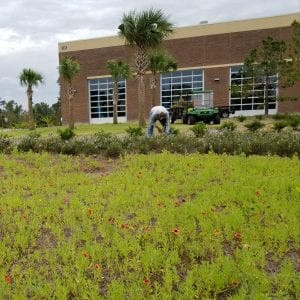Environmental Horticulture

One of our recent campus construction projects features our boldest attempt yet to incorporate native flowering plants into our campus landscape designs. The landscape at the new District Energy Plant IV was designed by Karina Veaudry, Principal Landscape Architect of NFC Landscape Architects, Inc., working under project architecture firm RLF. NFC is guided by a philosophy that promotes the benefits of biodiverse, native landscapes. This project is a shining example of what can be achieved with native plant landscaping.
The cornerstone of the landscape is at the intersection of East Gemini and Scorpius Street, featuring stunning large masses of blanket flower (Gaillardia), and Georgia calamint (Calamintha georgiana hybrid). Gaillardia is a sturdy native perennial that puts on a long-lasting bloom of bright orange and yellow, daisy-like flowers. The hybrid calamint is a wondrously fragrant, robust, perennial shrub that produces nearly continuous blooms of lavender/white spotted mint flowers attractive to a host of native bees, butterflies and other pollinators. It reaches a height of about 12 to 18 inches and serves as an excellent low border shrub.
One of the challenges of using native species such as blanket flower and calamint is figuring out how to maintain them in the landscape. Lack of familiarity with these plants creates uncertainty for the landscape maintenance crews. The Arboretum and Landscape and Natural Resources Department are committed to determining which native plants work best in our landscapes, and what techniques or special approaches are needed for maintenance. Our goal is to develop and demonstrate best practices, so that others are inspired to include these wonderful plants in their landscape repertoire.
Last fall, after the Gaillardia bloom began to peter out, the landscape crew decided to trim the stems to the ground with a line trimmer. They then removed all the cut stems and covered the area with pine straw. As you can see from the banner photo for this story, the Gaillardia has resprouted strongly during this warm winter, and it has already begun to fill in with blooms.
During the last week of February, we decided to cut back the calamint to expose the new bright green growth at the core of the plants. Calamint can get a bit “leggy” on old growth, so we are testing whether a hard prune back in springtime will lead to lush, new growth. If this is successful it would allow us to do one annual spring pruning to maintain vibrant growth and flowing throughout the year. As we develop successful management approaches, we will share them through outreach and education to encourage winder adoption of these brilliant plants.
Other natives included in this landscape design are: Coontie (Zamia pumila), Firebush (Hamelia patens), Flatwoods Plum (Prunus umbellata), dwarf Walter’s Viburnum (Viburnum obovatum), Slash Pine (Pinus elliottii), Sand Cordgrass (Spartina bakeri), Yaupon Holly (Ilex vomitoria), Saw Palmetto (Seranoa repens), Cabbage Palm (Sabal palmetto), and Live Oak (Quercus virginiana), in addition to a few introduced horticultural varieties.
